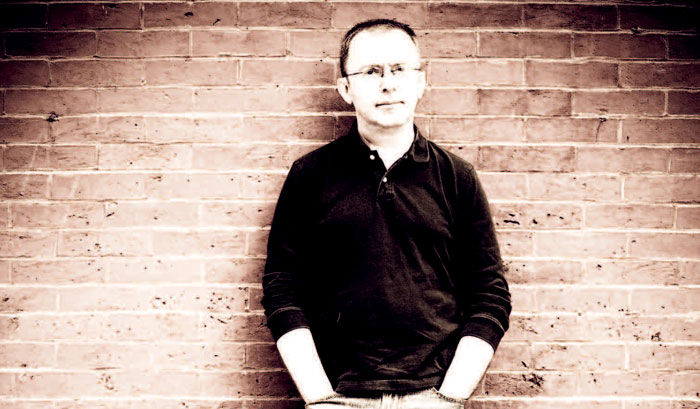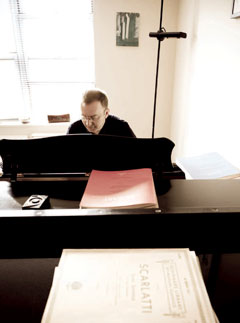


PEDJA MUZIJEVIC IS ONE OF TODAY'S most adventurous classical performers. The Sarajevo-born, New York City-based pianist has won praise and prizes for his solo recitals, orchestral and chamber performances, and collaborations with such leading dance troupes as Mikhail Baryshnikov's White Oak Dance Project and the Trisha Brown Dance Company.
When we spoke to Pedja Muzijevic (pronounced "PEH-ja MOO-zhee-eh-vitch"), he was performing a typically ambitious series of programs at the Spoleto USA festival in Charleston, South Carolina. "Tomorrow I play a Schumann piano quintet. The concert after that is a J.S. Bach gamba sonata and Béla Bartók's Contrasts, and after that, a premiere of a wonderful new piece by Jonathan Berger. I love performing in such a constant mix of styles, though it does create havoc in my life!'"
I admire how Yamaha works to improve their pianos. They are constantly tweaking them and trying to figure out how to make things even better.
Musijevic's wide-ranging career is reflected in his recent solo piano release, Sonatas and Other Interludes. In a daring stroke of programming, the pianist intersperses 18th-and 19th-century keyboard works with movements from Sonatas and Interludes, John Cage's 1948 masterwork. Cage's score calls for the performer to "prepare" the piano by inserting dozens of pieces of hardware-screws, nuts, bits of rubber and plastic-between the piano strings. This transforms the piano into a virtual percussion orchestra generating clanks, thunks, and eerie, bell-like tones.
"Other musicians had prepared pianos before Cage, but he's the one who really explored and played with it," says Muzijevic. "The story goes that he was asked to create works for a dance company that only had money for a piano, but he wanted to create something that sounded like more than one instrument."

In practice, it's impossible to play Cage's prepared pieces and conventional piano works on the same instrument in the same concert. This is one reason why it's so startling to hear a collection that veers from Cage to Schumann to Cage to Liszt.
"Often the people who play Cage don't play Schumann, and vice versa," observes Pedja. "But I love both, and I don't feel one excludes the other. Still, it took me four years to decide on the program for this particular recording. I kept thinking, 'Who needs another Chopin disc? What can I do that's interesting and different?'"
Muzijevic began playing at age nine-a relatively late start for a leading classical instrumentalist. "My family are all upstanding engineers," he says with a laugh. "I'm the only musician." After studying in Sarajevo (now part of Bosnia and Herzegovina) and Zagreb, Croatia, he moved to the States in 1984 to attend Philadelphia's Curtis Institute of Music, followed by graduate studies at Julliard. "It was a pretty orthodox training," he says. "I played some new music, but didn't mix it up so much."
Pedja credits his move toward bolder programming in part to his years working with dancers. "Dancers actually tend to be a bit more adventurous in their musical tastes than many people in the music world," he says. "I was lucky to work with some truly great dancers, and I learned a lot from them and the very wide range of music they used."
Muzijevic is a longtime Yamaha piano user. "I've played them all my life, here and there," he says, "but my active involvement started about twenty years ago. Yamaha pianos impress me on several levels: the actual instruments, the care that Yamaha Artist Services puts into them, and the relationships Yamaha maintains with its artists. I admire how Yamaha works to improve their pianos. There's never a sense that their attitude is, 'We've made a great piano, now let's just Xerox it.' They are constantly tweaking them and trying to figure out how to make things even better. And of course, I used a Yamaha to make Sonatas and Other Interludes."
At home, Pedja plays a Yamaha Disklavier-but not for its recording and playback functions. "It's just a great old piano that I bought from Yamaha Artist Services. I'd used it in a rehearsal with the Trisha Brown Dance Company when I was working on her staging of Schubert's Winterreise. I really loved it, and asked if it was up for sale. Fortunately, it was."
Muzijevic is already planning his work for the 2011-2012 concert season, so expect further bold programming and interpretation decisions-though Pedja doesn't necessarily view them as "choices." "I never take a piece and say, 'I think I'll do it such-and-such a way,'" he says. "There's always one inevitable way that it seems to me it should be played. For me, interpretation is simply the way you hear music. It's not something you put on. It's who you are."
(Photography Credit: Rob Shanahan)
























